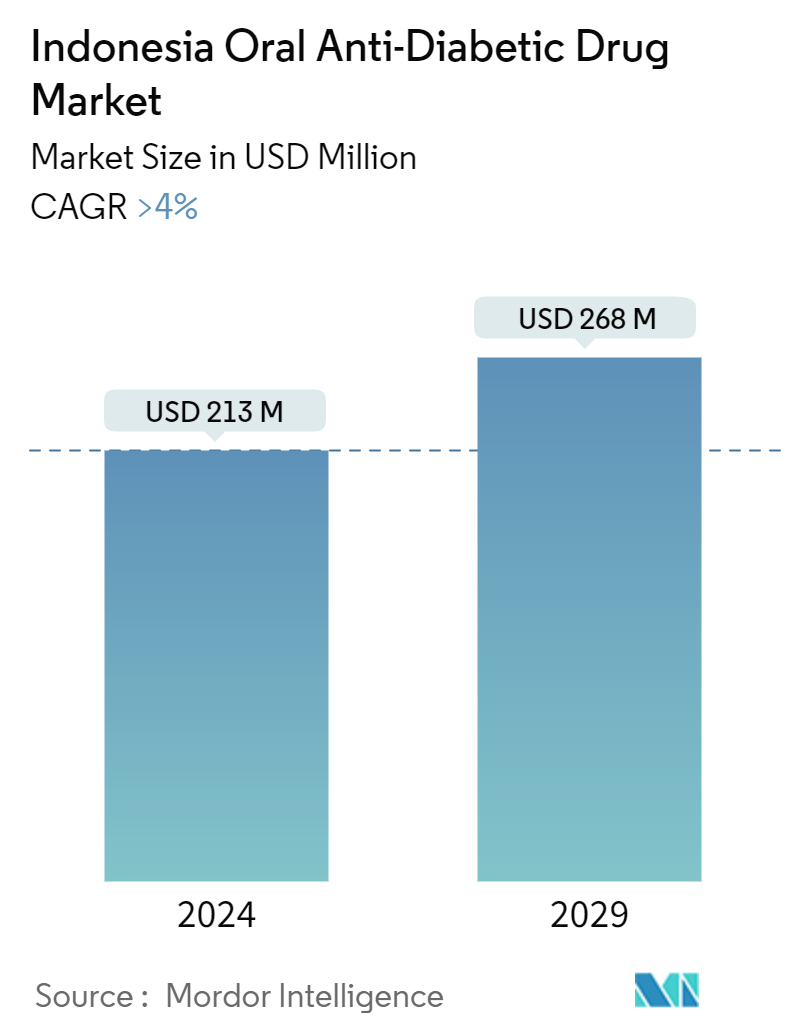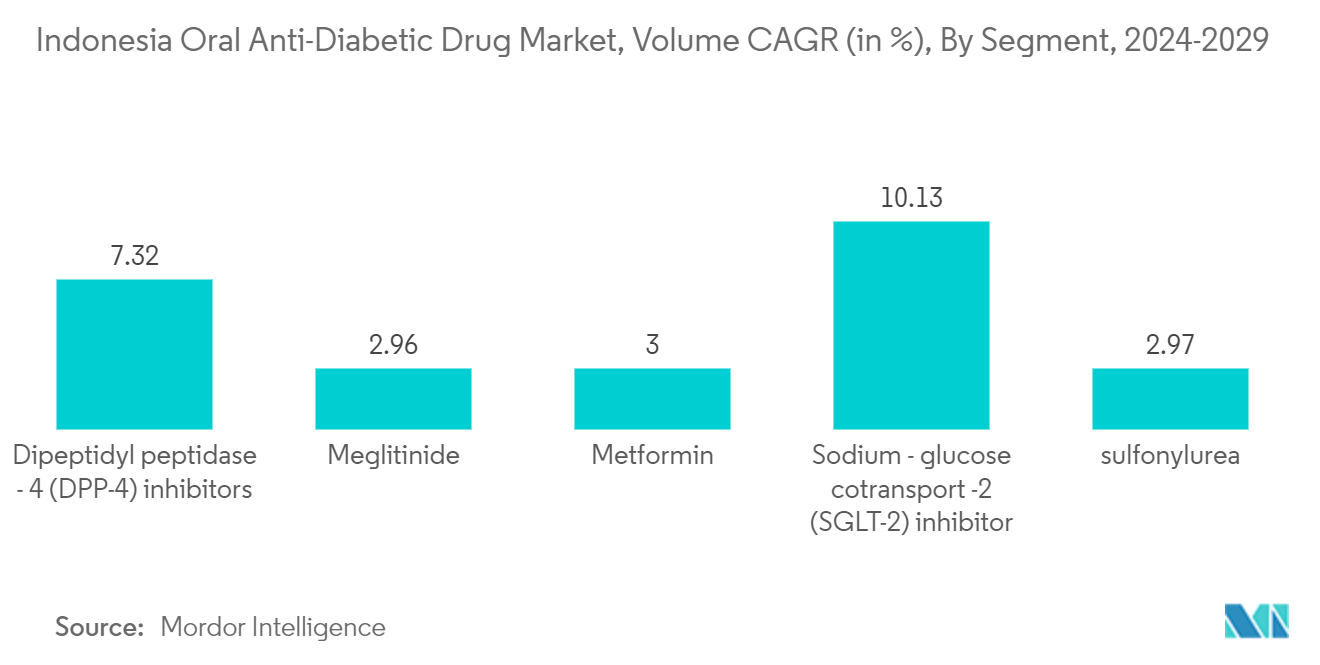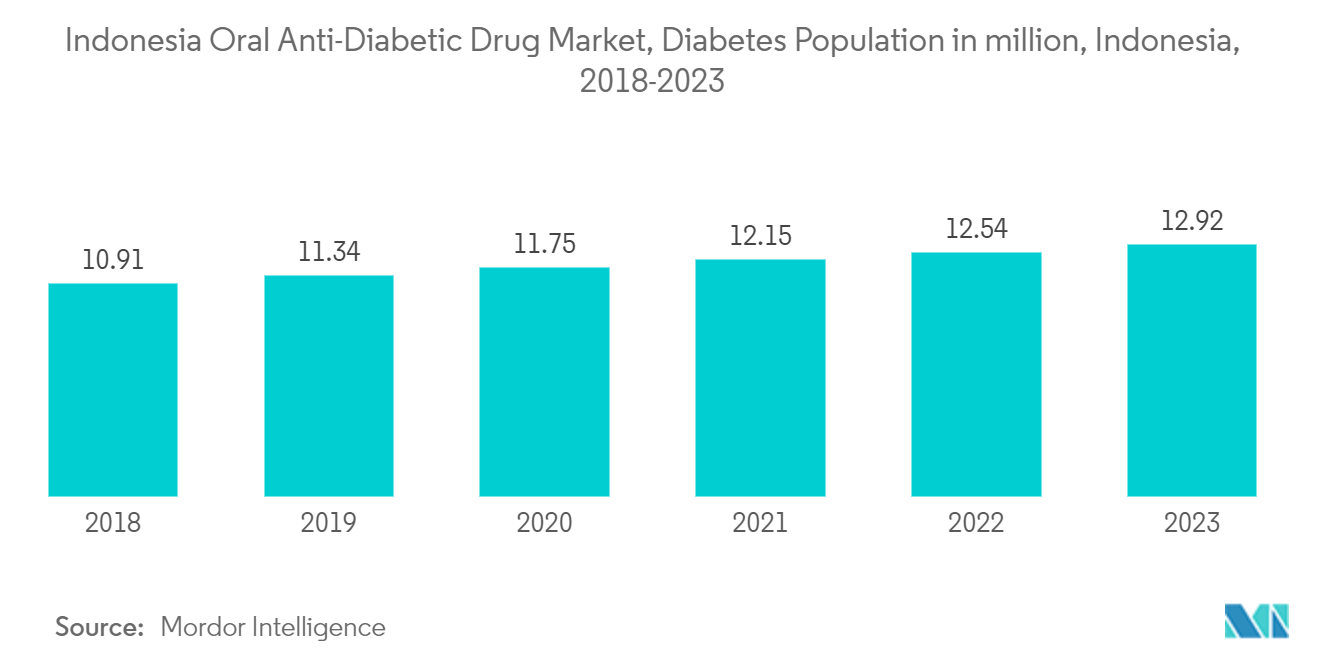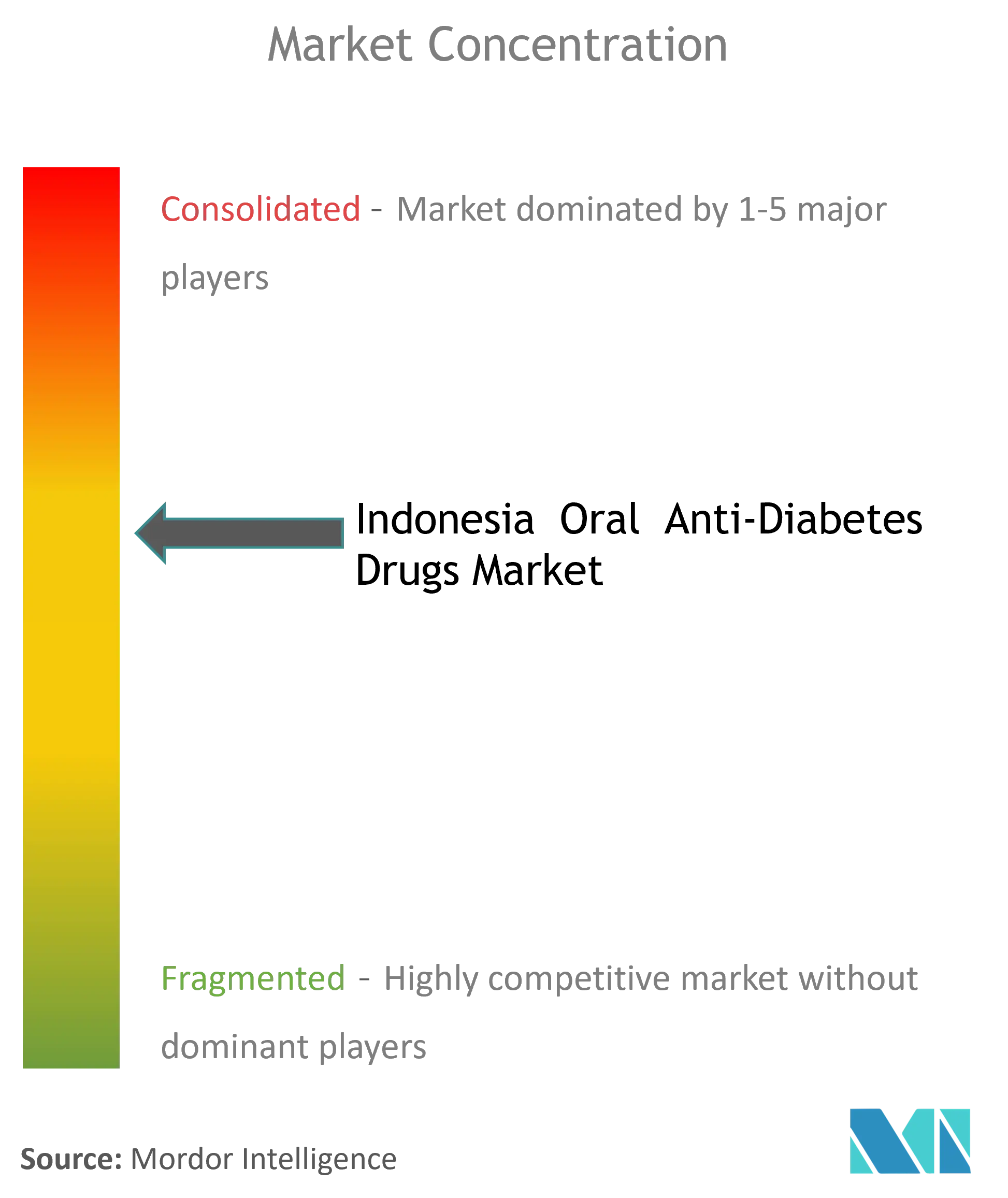Indonesia Oral Anti-Diabetic Drug Market Size

| Study Period | 2019 - 2029 |
| Base Year For Estimation | 2023 |
| Forecast Data Period | 2024 - 2029 |
| Market Size (2024) | USD 213 Million |
| Market Size (2028) | USD 268 Million |
| CAGR (2024 - 2029) | 4.00 % |
Major Players
*Disclaimer: Major Players sorted in no particular order |
Indonesia Oral Anti-Diabetic Drug Market Analysis
The Indonesia Oral Anti-Diabetic Drug Market size is estimated at USD 213 million in 2024, and is expected to reach USD 268 million by 2028, growing at a CAGR of greater than 4% during the forecast period (2024-2028).
In Indonesia, diabetes is seen as a serious health issue and has raised concerns. The insulin medication category holds a substantial market share. Insulin is used by more than 100 million individuals globally, including 100% of those with Type 1 diabetes and 10% to 25% of those with Type 2 diabetes. Only a few insulin producers operate on the market, and insulin production is complex. As a result, there is intense competition among these companies, which always work to meet patients' needs by offering insulin of the best caliber.
To address the rising number of diabetics in Indonesia, diabetes professionals have developed suggestions for avoiding and controlling the disease. To avoid major side effects such as neuropathy, nephropathy, retinopathy, microvascular disease, and cardiovascular disease, diabetes control is essential.
Modern methods for managing diabetes still include pharmacologic therapy, such as oral medications and insulin, as well as non-pharmacologic therapies, such as lifestyle modifications. These treatments are only accessible because of diabetes education programs that encourage self-care. In Indonesia, healthcare professionals provide diabetes education programs. A lack of skilled healthcare professionals (HCPs) to teach people with diabetes is caused by the limited availability of certified diabetic educators in Indonesia.
Indonesia Oral Anti-Diabetic Drug Market Trends
Sulfonylureas Segment Occupied the Highest Market Share in the Indonesia Oral Anti-Diabetic Drugs Market in the current year.
Regarding revenue, the Sulfonylureas segment is anticipated to lead the Indonesia Oral Anti-Diabetic Drugs Market and post a CAGR of over 1% during the forecast year. Among the several Oral anti-diabetes drugs available, sulfonylureas (SUs) constitute one of the key pharmacotherapeutic agents in managing T2DM.
In Indonesia, healthcare professionals provide diabetes education programs. A lack of skilled healthcare professionals (HCPs) to teach people with diabetes is caused by the limited availability of certified diabetic educators in Indonesia. Little evidence is available about how people with diabetes learn about their condition after acquiring diabetes-related information formally or informally through formal educational programs in Indonesia. Sulfonylureas, combined with metformin, are one of the oral AHAs often recommended in low- and middle-income (LMIC) nations of Asia and Africa.
This family of medications lowers hyperglycemia and glycated hemoglobin (HbA1c) levels in T2DM patients by increasing insulin release from Beta-cells. According to the hierarchy of development, the SUs are divided into first- and second-generation SUs, and according to the length of time they are active, they are categorized as short, intermediate, and long-acting SUs. Clinical trials have indicated that fixed-dose combinations of SUs plus metformin or other glucose-lowering drugs are safe and effective. The National List of Necessary Medicines (NLEM) issued by numerous nations in the African, Middle Eastern and North African, and Southeast Asian area includes the SUs as one of the necessary AHAs.

The increasing Diabetes Population in the Indonesia is driving the market.
People with diabetes in Indonesia rank sixth in the world, along with China, India, the United States, Brazil, and Mexico, with an estimated number of people with diabetes of 12 million. It is expected to increase to 17 million people in 2045. Indonesia is the eighth most diabetic country in the world. The national government's insurance program mostly covers people's health costs in Indonesia. Medical necessities, including consultations, hospital stays, insulin, and needles, are covered by government insurance when obtained through certain clinics, hospitals, or licensed pharmacies. However, a misconception developed because of a lack of awareness and information about type 1 diabetes, leading to restrictions on insulin access.
The quantity of insulin covered by government insurance was restricted. For instance, a kid with type 1 diabetes who needed eight insulin pens per month was only provided five, forcing the parents to pay for the other three pens independently. They were not allowed to give their child medication if they did not have the money. In Indonesia, healthcare professionals provide diabetes education programs.
A lack of skilled healthcare professionals (HCPs) to teach people with diabetes is caused by the limited availability of certified diabetic educators in Indonesia. Little evidence is available about how people with diabetes learn about their condition after acquiring diabetes-related information formally or informally through formal educational programs in Indonesia. The absence of comprehensive health insurance in Indonesia makes creating a responsive healthcare system more difficult. The government wants everyone to have access to health care.
The main public health insurance program is Askeskin/Jamkesmas, a national health insurance scheme for the underprivileged. Askes provides health insurance to retired military members and governmental servants. Jamsostek covers the formal sector. Meanwhile, just around 3% of people have private health insurance.

Indonesia Oral Anti-Diabetic Drug Industry Overview
The Indonesian oral anti-diabetes drug market is consolidated, with a few major manufacturers like Eli Lilly, AstraZeneca, Sanofi, and Janssen Pharmaceuticals having a global market presence, while the remaining manufacturers are confined to the other local or regional markets. Companies are focusing on innovations in diabetes drugs.
Indonesia Oral Anti-Diabetic Drug Market Leaders
-
Astrazeneca
-
Astellas
-
Janssen
-
Eli Lilly
-
Sanofi
*Disclaimer: Major Players sorted in no particular order

Indonesia Oral Anti-Diabetic Drug Market News
- March 2023: Daewoong Pharmaceutical's Envlo (SGLT-2 Drug) will enter the global market in full swing by filing for product licenses in three ASEAN countries. Submitted an NDA to Indonesia, the Philippines, and Thailand.
- May 2022: Mounjaro (tirzepatide) injection to improve blood sugar control in adults with type 2 diabetes was approved as an addition to diet and exercise. Mounjaro was effective at improving blood sugar and was more effective than the other diabetes therapies with which it was compared in clinical studies.
Indonesia Oral Anti-Diabetic Drug Market Report - Table of Contents
1. INTRODUCTION
- 1.1 Study Assumptions and Market Definition
- 1.2 Scope of the Study
2. RESEARCH METHODOLOGY
3. EXECUTIVE SUMMARY
4. MARKET DYNAMICS
- 4.1 Market Overview
- 4.2 Market Drivers
- 4.3 Market Restraints
-
4.4 Porter's Five Forces Analysis
- 4.4.1 Bargaining Power of Suppliers
- 4.4.2 Bargaining Power of Consumers
- 4.4.3 Threat of New Entrants
- 4.4.4 Threat of Substitute Products and Services
- 4.4.5 Intensity of Competitive Rivalry
5. MARKET SEGMENTATION
-
5.1 Oral Anti-diabetic drugs
- 5.1.1 Biguanides
- 5.1.1.1 Metformin
- 5.1.2 Alpha-Glucosidase Inhibitors
- 5.1.2.1 Alpha-Glucosidase Inhibitors
- 5.1.3 Dopamine D2 receptor agonist
- 5.1.3.1 Bromocriptin
- 5.1.4 SGLT-2 inhibitors
- 5.1.4.1 Invokana (Canagliflozin)
- 5.1.4.2 Jardiance (Empagliflozin)
- 5.1.4.3 Farxiga/Forxiga (Dapagliflozin)
- 5.1.4.4 Suglat (Ipragliflozin)
- 5.1.5 DPP-4 inhibitors
- 5.1.5.1 Onglyza (Saxagliptin)
- 5.1.5.2 Tradjenta (Linagliptin)
- 5.1.5.3 Vipidia/Nesina(Alogliptin)
- 5.1.5.4 Galvus (Vildagliptin)
- 5.1.6 Sulfonylureas
- 5.1.6.1 Sulfonylureas
- 5.1.7 Meglitinides
- 5.1.7.1 Meglitinides
6. MARKET INDICATORS
- 6.1 Type-1 Diabetic Population
- 6.2 Type-2 Diabetic Population
7. COMPETITIVE LANDSCAPE
-
7.1 COMPANY PROFILES
- 7.1.1 Takeda
- 7.1.2 Novo Nordisk
- 7.1.3 Pfizer
- 7.1.4 Eli Lilly
- 7.1.5 Janssen Pharmaceuticals
- 7.1.6 Astellas
- 7.1.7 Boehringer Ingelheim
- 7.1.8 Merck And Co.
- 7.1.9 AstraZeneca
- 7.1.10 Bristol Myers Squibb
- 7.1.11 Novartis
- 7.1.12 Sanofi
- *List Not Exhaustive
8. MARKET OPPORTUNITIES AND FUTURE TRENDS
** Subject To AvailablityIndonesia Oral Anti-Diabetic Drug Industry Segmentation
Orally administered antihyperglycemic drugs reduce blood glucose levels. They are often used in type 2 diabetes care. Indonesia's Oral Anti-Diabetic Drug Market is set to witness a CAGR of more than 4% during the forecast period. Indonesia Oral Anti-Diabetic Drug Market is segmented into drugs (Biguanides, Alpha-glucosidase inhibitors, Dopamine-D2 receptor agonists, Sodium-glucose Cotransport-2 (SGLT-2) inhibitor, Dipeptidyl Peptidase-4 (DPP-4) Inhibitors, Sulfonylureas, and Meglitinides). The report offers the market size in value terms in USD for all the abovementioned segments.
| Oral Anti-diabetic drugs | Biguanides | Metformin |
| Oral Anti-diabetic drugs | Alpha-Glucosidase Inhibitors | Alpha-Glucosidase Inhibitors |
| Oral Anti-diabetic drugs | Dopamine D2 receptor agonist | Bromocriptin |
| Oral Anti-diabetic drugs | SGLT-2 inhibitors | Invokana (Canagliflozin) |
| Jardiance (Empagliflozin) | ||
| Farxiga/Forxiga (Dapagliflozin) | ||
| Suglat (Ipragliflozin) | ||
| Oral Anti-diabetic drugs | DPP-4 inhibitors | Onglyza (Saxagliptin) |
| Tradjenta (Linagliptin) | ||
| Vipidia/Nesina(Alogliptin) | ||
| Galvus (Vildagliptin) | ||
| Oral Anti-diabetic drugs | Sulfonylureas | Sulfonylureas |
| Oral Anti-diabetic drugs | Meglitinides | Meglitinides |
Indonesia Oral Anti-Diabetic Drug Market Research Faqs
How big is the Indonesia Oral Anti-Diabetic Drug Market?
The Indonesia Oral Anti-Diabetic Drug Market size is expected to reach USD 213 million in 2024 and grow at a CAGR of greater than 4% to reach USD 268 million by 2028.
What is the current Indonesia Oral Anti-Diabetic Drug Market size?
In 2024, the Indonesia Oral Anti-Diabetic Drug Market size is expected to reach USD 213 million.
Who are the key players in Indonesia Oral Anti-Diabetic Drug Market?
Astrazeneca, Astellas, Janssen, Eli Lilly and Sanofi are the major companies operating in the Indonesia Oral Anti-Diabetic Drug Market.
What years does this Indonesia Oral Anti-Diabetic Drug Market cover, and what was the market size in 2023?
In 2023, the Indonesia Oral Anti-Diabetic Drug Market size was estimated at USD 204.48 million. The report covers the Indonesia Oral Anti-Diabetic Drug Market historical market size for years: 2019, 2020, 2021, 2022 and 2023. The report also forecasts the Indonesia Oral Anti-Diabetic Drug Market size for years: 2024, 2025, 2026, 2027, 2028 and 2029.
Indonesia Oral Anti-Diabetic Drug Industry Report
Statistics for the 2024 Indonesia Oral Anti-Diabetic Drug market share, size and revenue growth rate, created by Mordor Intelligence™ Industry Reports. Indonesia Oral Anti-Diabetic Drug analysis includes a market forecast outlook to for 2024 to 2029) and historical overview. Get a sample of this industry analysis as a free report PDF download.



